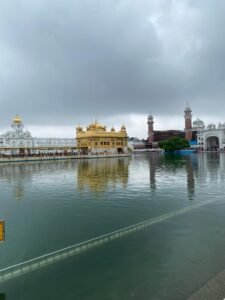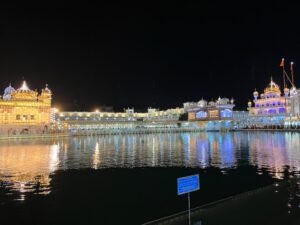Golden Temple Amritsar: A Sacred Marvel of Human Brotherhood and Sikh Heritage
The Golden Temple, also known as Sri Harmandir Sahib, stands as a testament to the unity and heritage of the Sikh community. It’s not merely a place of worship; it symbolizes the ideals of equality and human brotherhood. Let’s delve into the significance, history, and unique features of this sacred marvel.
Introduction
The Golden Temple, situated in Amritsar, India, is not just a religious shrine for the Sikhs but a symbol of inclusivity and shared humanity. Its significance transcends religious boundaries and stands as a beacon of harmony and unity.

Significance of the Golden Temple
The Golden Temple represents the soul of Sikhism, emphasizing spiritual solace and equality for all, regardless of social status or background. It serves as a sanctuary where individuals, irrespective of their caste, creed, or race, can find spiritual solace and fulfillment.
The Philosophy and Ideology
To comprehend the essence of the Golden Temple is to experience its divine aura, as it embodies a philosophy that surpasses verbal description. The teachings of the Sikh Gurus, especially those of Guru Arjan Sahib, are imbued within its golden walls.
The History of Sri Harmandir Sahib
In the realm of spirituality, a beacon of reverence gleams resplendent, its allure transcending linguistic barriers. Sri Harmandir Sahib, revered as Sri Darbar Sahib or the Golden Temple, stands as a testament to the divine vision of Guru Arjan Sahib, the Fifth Nanak. Within the depths of his enlightened mind, the concept of a central sanctuary for the Sikh faith took root. With meticulous care, he meticulously crafted the architectural marvel that would serve as a focal point of devotion for Sikhs across the globe. Prior to this momentous undertaking, Guru Amardas Sahib, the Third Nanak, had envisioned the excavation of a sacred tank, known as Amritsar or Amrit Sarovar. Under the watchful guidance of Baba Budha ji, Guru Ramdas Sahib brought this vision to fruition.

The land upon which this spiritual oasis would reside was acquired through amicable means, either through purchase or donation from the benevolent Zamindars (landlords) of the surrounding villages. Concurrent with the construction of the holy tank, a plan for the establishment of a flourishing town was meticulously devised. In 1570, the arduous task of bringing these grand visions to life commenced. With unwavering dedication and unwavering faith, the artisans toiled tirelessly, their efforts culminating in the completion of both the Sarovar and the town in 1577 A.D.
From that day forward, Sri Harmandir Sahib has stood as a beacon of hope and enlightenment, its ethereal beauty captivating the hearts of pilgrims from all corners of the world. Within its sacred precincts, devotees find solace and inspiration, their spirits soaring as they immerse themselves in the divine presence that permeates the very air.
As the Sikhs recite their Ardas, their daily prayers, a fervent yearning to pay obeisance at this holy site fills their hearts. For Sri Harmandir Sahib is not merely a structure of stone and mortar, but a manifestation of the divine, a sanctuary where the soul finds solace and communion with the Almighty.
The Vision of Guru Arjan Sahib
Guru Arjan Sahib envisioned a place of worship that would reflect the essence of Sikhism. Unlike traditional Hindu temple architecture, the Golden Temple was built at a lower level, with entrances on all four sides, symbolizing the open arms of Sikhism, welcoming all.
The Construction of the Holy Tank
The excavation of the holy tank, Amrit Sarovar, was initiated by Guru Ramdas Sahib and later brick-lined by Guru Arjan Sahib, adding to the structural grandeur of Sri Harmandir Sahib.

The Installation of Sri Guru Granth Sahib
The installation of Sri Guru Granth Sahib in 1604 marked a significant milestone in the history of the Golden Temple, elevating it to the status of a revered pilgrimage center for the Sikh community.
The Unique Architecture
The architecture of the Golden Temple is an amalgamation of Hindu and Islamic styles, showcasing the distinctive Sikh school of construction. The lower level construction emphasizes humility, while the four entrances signify equality among all human beings.
The Lesson of Egalitarianism
The construction’s lower level design, contrary to traditional Hindu temple architecture, highlights the Sikh philosophy of egalitarianism, emphasizing the importance of humility and equality among all individuals.
The Four Entrances
The presence of four entrances, facing all directions, symbolizes the inclusivity and openness of the Sikh faith, welcoming individuals from all walks of life to seek spiritual solace.
A Symbol of Human Unity
The Golden Temple’s unique architecture and ideology serve as a potent symbol of human unity and brotherhood, transcending the barriers of caste, creed, and religion.
The Historical Legacy
The historical legacy of the Golden Temple is deeply embedded in the narrative of Sikh history and the struggles faced by the Sikh community. It represents the resilience and perseverance of a community that has upheld its values through the test of time.
Golden Temple Photos (Golden Temple Wallpaper)
The Golden Temple’s historical legacy is further enriched by a collection of rare old photos that depict the evolution and transformation of this sacred place over the centuries.










Who Donated Land to the Golden Temple
Upon securing the land through amicable means, Guru Ram Das Sahib embarked on the momentous task of constructing a sacred edifice that would serve as a beacon of enlightenment for all.
On the auspicious day of Magh 1, 1645 Bikrmi Samvat (December, 1588), Hazrat Mian Mir ji, a revered Muslim saint from Lahore, laid the foundation stone of this magnificent structure.
Under the watchful eye of Guru Arjan Sahib, the construction work proceeded with unwavering dedication. Prominent Sikh personalities such as Baba Budha ji, Bhai Gurdas ji, Bhai Sahlo ji, and countless other devoted Sikhs lent their unwavering support to the endeavor.
In a bold departure from traditional Hindu temple architecture, Guru Arjan Sahib envisioned a sanctuary that would be accessible to all, regardless of caste, creed, sex, or religion. He instructed that the structure be built on a lower level, symbolizing humility and the need to shed one’s ego before entering the presence of the divine. Furthermore, he decreed that the temple have four entrances, signifying the openness and inclusivity of the Sikh faith.
Thus, a symbol of a new faith took shape, its very design embodying the core principles of Sikhism.
Over the course of several years, the artisans toiled tirelessly, their efforts culminating in the completion of the magnificent structure in 1601 A.D. (Bhadoon Sudi 1, 1661 Bikrmi Samvat).
With immense reverence, Guru Arjan Sahib installed the newly created Guru Granth Sahib, the holy scripture of Sikhism, within the sanctum sanctorum of the temple. He also appointed Baba Budha ji as the first Granthi, the revered custodian of the sacred text.
From that day forward, Sri Harmandir Sahib has stood as a radiant beacon of hope and enlightenment, its ethereal beauty captivating the hearts of pilgrims from all corners of the globe.
The Sikhs rejoiced, for they now had their own sacred pilgrimage center, a sanctuary where they could come together to celebrate their faith and immerse themselves in the divine presence.
The Vision of Guru Arjan Sahib
The visionary leadership of Guru Arjan Sahib remains an integral part of the Golden Temple’s narrative, as his architectural insights and spiritual vision shaped the foundation of this sacred edifice.
The Architecture: A Blend of Cultures
The Golden Temple’s unique architecture is a testament to the harmonious blend of Islamic and Hindu styles, creating a distinct Sikh architectural identity that is celebrated across the globe.
The Symbolism of the Construction
Every aspect of the Golden Temple’s construction carries deep symbolism, reflecting the core values and beliefs of the Sikh faith, emphasizing equality, humility, and inclusivity.
Guru Ka Langar: A Tradition of Service
In the Sikh faith, the concept of Langar holds immense significance, embodying the core values of compassion, equality, and selfless service. Bhai Desa Singh, a revered Sikh scholar, aptly captured the essence of Langar, stating that a Sikh who is blessed with abundance must extend their generosity to those in need, particularly travelers and pilgrims from distant lands. Maharaja Ranjit Singh, a devout Sikh ruler, recognized the profound importance of Langar and made generous grants of jagirs (landholdings) to gurdwaras (Sikh temples) to ensure the sustenance of this sacred tradition. Other Sikh rulers followed suit, establishing similar endowments to support Langar.
As a result of these efforts, practically every gurdwara today has a Langar that is sustained by the contributions of the community. In smaller gurdwaras, cooked food may be donated by various households, ensuring that no pilgrim or visitor ever goes hungry. For Sikhs, sharing a meal while seated together in a pangat (row) is not merely a social gathering, but a deeply spiritual act. It is a manifestation of their belief in the oneness of humanity, regardless of caste, creed, or social status.
Participating in the preparation, serving, and cleaning of Langar is considered a form of seva (selfless service), a highly meritorious act in Sikhism. By contributing their time and effort to Langar, Sikhs demonstrate their commitment to the welfare of the community and their dedication to the ideals of their faith. The Sikh ideal of charity is not merely individualistic, but deeply rooted in the concept of social responsibility. Sikhs are obligated to contribute one-tenth of their earnings (dasvand) towards the betterment of the community. In addition to financial contributions, Sikhs are also encouraged to offer the service of their hands, with seva rendered in Langar being considered particularly meritorious.
In essence, Langar is a living embodiment of the Sikh principles of compassion, equality, and selfless service. It is a beacon of hope and nourishment for all who seek it, a testament to the enduring power of faith and community.
The Importance of Langar to Sikhism
Langar holds immense significance in Sikhism, not just as a means of providing meals but as a platform for fostering community participation, equality, and humility among all individuals.
Art and Architecture at the Golden Temple
The Golden Temple’s architecture is a masterpiece of craftsmanship, with intricate gold-embossed work and exquisite inlay designs adorning its walls, showcasing the artistic brilliance of Sikh craftsmen.
The Golden Temple, with its rich history, unique architecture, and profound spiritual significance, stands as a testament to the values of inclusivity and human unity upheld by the Sikh community for generations.
Hotel near Golden Temple
Here are some hotels near the Golden Temple:
- Hotel Star Inn – ₹886 per night
- Hotel Sapphire Opposite Golden Temple – ₹2,524 per night
- Hotel Regal – ₹1,645 per night
- Hotel frndz inn – ₹1,222 per night
- Hotel Robin – ₹884 per night
FAQs
1. What is the historical significance of the Golden Temple in Amritsar? The Golden Temple holds significant historical importance as it serves as a central religious place for Sikhs and symbolizes human brotherhood and equality, irrespective of caste, creed, or race.
2. How did the construction of the Golden Temple reflect Sikh ideology? The construction of the Golden Temple, with its lower level design and four entrances from all directions, symbolizes the Sikh principles of humility, egalitarianism, and inclusivity, welcoming people from all walks of life.
3. What is the symbolism behind the four entrances of the Golden Temple? The four entrances of the Golden Temple signify the openness of the Sikh faith, emphasizing that individuals from every background are equally welcome to seek spiritual solace and solace within its sacred premises.
4. What role does the Langar (community kitchen) play in the Sikh tradition? The Langar, an integral part of Sikhism, serves not only as a place to provide meals but also as a platform for fostering community participation, equality, and humility among all individuals.
5. How does the architecture of the Golden Temple reflect a blend of cultures? The unique architecture of the Golden Temple reflects a harmonious blend of Islamic and Hindu styles, showcasing the distinct Sikh architectural identity that has gained recognition worldwide.
6. What makes the Golden Temple a symbol of human unity? The Golden Temple, through its architectural design, philosophy, and historical legacy, stands as a symbol of human unity, transcending the boundaries of caste, creed, and religion.
7. How did the Golden Temple evolve over the centuries? The collection of rare old photos of the Golden Temple provides a glimpse into its historical evolution, showcasing the changes and transformations that have taken place over the centuries.
8. How does the Golden Temple promote the values of inclusivity and equality? The Golden Temple, through its teachings and practices, promotes the values of inclusivity and equality by providing spiritual solace and communal service to all individuals, regardless of their background.
9. What is the significance of the installation of Sri Guru Granth Sahib in the Golden Temple? The installation of Sri Guru Granth Sahib in the Golden Temple marked a significant milestone in Sikh history, elevating the temple to the status of a revered pilgrimage center and a spiritual sanctuary for the Sikh community.
10. How does the Golden Temple represent the resilience and perseverance of the Sikh community? The Golden Temple’s historical legacy represents the resilience and perseverance of the Sikh community in upholding its values and traditions through various challenges and adversities over the centuries.
You may also like to read about Firoza Gem Stone. Click Here.





